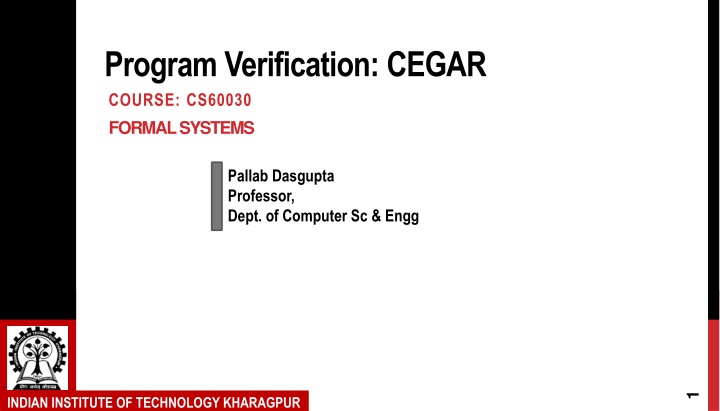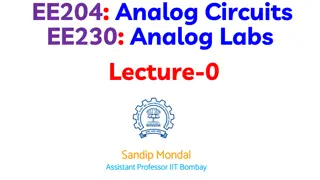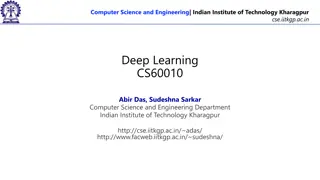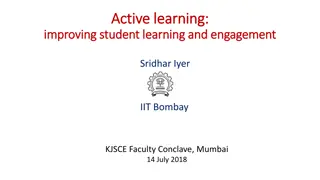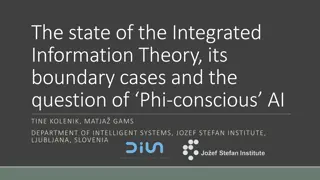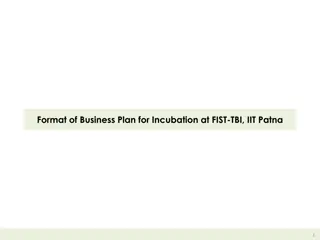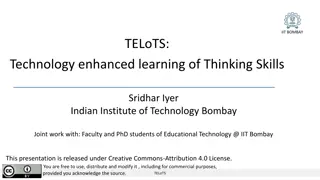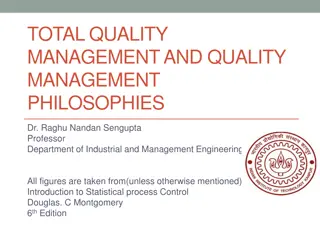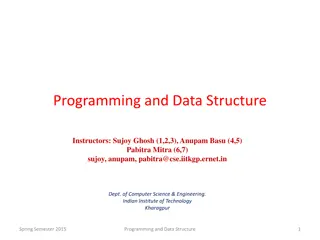CEGAR Course at IIT Kharagpur
Counterexample-guided Abstraction Refinement (CEGAR) is an iterative method for computing precise abstractions, initially used in hardware contexts. This approach involves computing abstractions, checking for errors, refining predicates, and checking feasibility. While effective for finite-state models, CEGAR lacks termination guarantees for infinite-state systems. The course at IIT Kharagpur provides an overview and practical applications of CEGAR in program verification.
Download Presentation

Please find below an Image/Link to download the presentation.
The content on the website is provided AS IS for your information and personal use only. It may not be sold, licensed, or shared on other websites without obtaining consent from the author.If you encounter any issues during the download, it is possible that the publisher has removed the file from their server.
You are allowed to download the files provided on this website for personal or commercial use, subject to the condition that they are used lawfully. All files are the property of their respective owners.
The content on the website is provided AS IS for your information and personal use only. It may not be sold, licensed, or shared on other websites without obtaining consent from the author.
E N D
Presentation Transcript
Program Verification: CEGAR COURSE: CS60030 FORMAL SYSTEMS Pallab Dasgupta Professor, Dept. of Computer Sc & Engg 1 INDIAN INSTITUTE OF TECHNOLOGY KHARAGPUR
Counterexample-guidedAbstraction Refinement CEGAR An iterative method to compute a sufficiently precise abstraction Initially applied in the context of hardware [Kurshan] 2 INDIAN INSTITUTE OF TECHNOLOGY KHARAGPUR
CEGAR Overview C program 1. Compute Abstraction 2. Check Abstraction [no error] OK 4. Refine Predicates 3. Check Feasibility [feasible] report counterexample 3 INDIAN INSTITUTE OF TECHNOLOGY KHARAGPUR
Counterexample-guidedAbstraction Refinement Claims: 1. This never returns a false error. 2. This never returns a false proof. 3. This is complete for finite-state models. 4. But: no termination guarantee in case of infinite-state systems 4 INDIAN INSTITUTE OF TECHNOLOGY KHARAGPUR
Computing Existential Abstractions of Programs C program 1. Compute Abstraction 2. Check Abstraction [no error] OK 4. Refine Predicates 3. Check Feasibility [feasible] report counterexample 5 INDIAN INSTITUTE OF TECHNOLOGY KHARAGPUR
Computing Existential Abstractions of Programs void main ( ) { bool p1 , p2 ; p1=TRUE ; p2=TRUE ; int main ( ) { int i ; p1 i=0 p2 even(i) + i = 0 ; while ( p2 ) { p1 = p1 ? FALSE : * ; p2= !p2 ; } } while ( even ( i ) ) i+ + ; } Predicates Boolean Program Minimal? C Program 6 INDIAN INSTITUTE OF TECHNOLOGY KHARAGPUR
Predicate Images Reminder: ????? ? = ? ? ? ?.?(?,? )} We need: ? ? ? ?. ?( ?, ? )} ????? ? = ????? ?is equivalent to: ?, ? ?2 ?,? ?2 .? ? = ? ? ? = ? ?(?,? ) } This is called the predicate image of T . 7 INDIAN INSTITUTE OF TECHNOLOGY KHARAGPUR
Enumeration Let s take existential abstraction seriously Basic idea: with n predicates, there are 2 2n n 2 2n n possible abstract transitions Let s just check them! 8 INDIAN INSTITUTE OF TECHNOLOGY KHARAGPUR
Enumeration: Example Predicates p1 p2 p3 i = 1 i = 2 even(i) T Basic Block i'= i + 1 i++; p'1p'2 p'3 p1 p2 p3 0 0 0 0 0 1 0 1 1 0 1 0 1 1 1 1 ? Query to Solver i 1 i 2 even(i) i'= i + 1 i' 1 i' 2 even(i') 0 1 0 1 0 1 0 1 0 0 0 0 1 1 1 1 0 0 1 1 0 0 1 1 0 1 0 1 0 1 0 1 9 INDIAN INSTITUTE OF TECHNOLOGY KHARAGPUR
Enumeration: Example Predicates p1 p2 p3 i = 1 i = 2 even(i) T Basic Block i'= i + 1 i++; p'1p'2 p'3 p1 p2 p3 0 0 0 0 0 1 0 1 1 0 1 0 1 1 1 1 Query to Solver i 1 i 2 even(i) i'= i + 1 i' 1 i' 2 even(i') ? 0 1 0 1 0 1 0 1 0 0 0 0 1 1 1 1 0 0 1 1 0 0 1 1 0 1 0 1 0 1 0 1 10 INDIAN INSTITUTE OF TECHNOLOGY KHARAGPUR
Enumeration: Example Predicates p1 p2 p3 i = 1 i = 2 even(i) T Basic Block i'= i + 1 i++; p'1p'2 p'3 p1 p2 p3 0 0 0 0 0 1 0 1 1 0 1 0 1 1 1 1 Query to Solver 0 1 0 1 0 1 0 1 0 0 0 0 1 1 1 1 0 0 1 1 0 0 1 1 0 1 0 1 0 1 0 1 . . . and so on . . . 11 INDIAN INSTITUTE OF TECHNOLOGY KHARAGPUR
Predicate Images Computing the minimal existential abstraction can be way too slow Use an over-approximation instead Fast(er) to compute But has additional transitions Examples: Cartesian approximation (SLAM) FastAbs (SLAM) Lazy abstraction (Blast) Predicate partitioning (VCEGAR) 12 INDIAN INSTITUTE OF TECHNOLOGY KHARAGPUR
Checking theAbstract Model C program 1. Compute Abstraction 2. Check Abstraction [no error] OK 4. Refine Predicates 3. Check Feasibility [feasible] report counterexample 13 INDIAN INSTITUTE OF TECHNOLOGY KHARAGPUR
Checking theAbstract Model No more integers! But: All control flow constructs, including function calls (more) non-determinism BDD-based model checking now scales 14 INDIAN INSTITUTE OF TECHNOLOGY KHARAGPUR
Finite-State Model Checkers: SMV Variables VAR b0_argc_ge_1 : boolean ; VAR b1 _argc_le_2147483646 : boolean ; VAR b2 : boolean ; VAR b3_nmemb_ge_r : boolean ; VAR b4 : boolean ; VAR b5_i_g e_8 : boolean ; VAR b6_i_g e_s : boolean ; VAR b7 : boolean ; VAR b8 : boolean ; VAR b9_s_g t_0 : boolean ; VAR b10_s_g t_1 : boolean ; . . . argc >= 1 argc <= 2147483646 argv[argc ] == NULL nmemb >= r p1 == &array[0] i >= 8 i >= s 1 + i >= 8 1 + i >= s s > 0 s > 1 15 INDIAN INSTITUTE OF TECHNOLOGY KHARAGPUR
Finite-State Model Checkers: SMV Control Flow -- program counter : 56 is the "terminating PC VAR PC : 0 . . 56 ; ASSIGN init (PC) := 0 ; -- i n i t i a l PC ASSIGN next (PC) : = case PC = 0 : 1 ; -- other PC = 1 : 2 ; -- other PC=19: case --goto ( with guard ) guard19 : 26 ; 1 : 20 ; esac ; . . . 16 INDIAN INSTITUTE OF TECHNOLOGY KHARAGPUR
Finite-State Model Checkers: SMV TRANS (PC=0) > next ( b0 _argc_ge_1)=b0_argc_ge_1 & next ( b1_argc_le_213646)=b1_argc_le_21646 & next (b2)=b2 & (! b30 & (! b17 & (! b30 & (! b17 & (! b54 | b60) TRANS (PC=1) > next ( b0_argc_ge_1)=b0_argc_ge_1 & next ( b1_argc_le_214646)=b1_argc_le_214746 & next (b2)=b2 & next (b3_nmemb_ge_r)=b3_nmemb_ge_ r & next (b4)=b4 & next ( b5_i_ge_8 )= b5_i_ge_8 & next ( b6_i_ge_s )= b6_i_ge_s . . . Data | b36) | !b30 | !b42 | !b30 | b42) | b48) | !b42 | b54) 17 INDIAN INSTITUTE OF TECHNOLOGY KHARAGPUR
Finite-State Model Checkers: SMV Property the specification file main.c line 20 column 12 function c :: very buggy function SPEC AG ( ( PC=51) > ! b23 ) 18 INDIAN INSTITUTE OF TECHNOLOGY KHARAGPUR
Finite-State Model Checkers: SMV If the property holds, we can terminate If the property fails, SMV generates a counterexample with an assignment for all variables, including the PC 19 INDIAN INSTITUTE OF TECHNOLOGY KHARAGPUR
Simulating the Counterexample C program 1. Compute Abstraction 2. Check Abstraction [no error] OK 4. Refine Predicates 3. Check Feasibility [feasible] report counterexample 20 INDIAN INSTITUTE OF TECHNOLOGY KHARAGPUR
LazyAbstraction The progress guarantee is only valid if the minimal existential abstraction is used. Thus, distinguish spurious transitions from spurious prefixes. Refine spurious transitions separately to obtain minimal existential abstraction SLAM: Constrain 21 INDIAN INSTITUTE OF TECHNOLOGY KHARAGPUR
LazyAbstraction One more observation: Each iteration only causes only minor changes in the abstract model Thus, use incremental Model Checker , which retains the set of reachable states between iterations (BLAST) 22 INDIAN INSTITUTE OF TECHNOLOGY KHARAGPUR
Example Simulation main() { int main() { int x, y; bool b0; // y>x b0=*; b0=*; y=1; x=1; Predicate: y>x if (b0) if (y>x) y ; b0=*; else else y++; b0=*; assert(y>x); assert(b0); } } 23 INDIAN INSTITUTE OF TECHNOLOGY KHARAGPUR
Example Simulation main() { int main() { int x, y; bool b0; // y>x b0=*; y=1; b0=*; x=1; Predicate: y>x if (b0) if (y>x) y ; b0=*; else else y++; b0=*; assert(y>x); assert(b0); } } 24 INDIAN INSTITUTE OF TECHNOLOGY KHARAGPUR
Example Simulation int main() { int x, y; y=1; x=1; We now do a path test, so convert to SSA. if (y>x) y ; else y++; assert(y>x); } 25 INDIAN INSTITUTE OF TECHNOLOGY KHARAGPUR
Example Simulation y1 = 1 x1 = 1 y1 > x1 y2 = y1 1 int main() { int x, y; y1=1; x1=1; if (y1>x1) y2=y1 1; (y2 > x0) else y++; This is UNSAT, so ? is spurious. assert(y2>x1); } 26 INDIAN INSTITUTE OF TECHNOLOGY KHARAGPUR
Refining the Abstraction C program 1. Compute Abstraction 2. Check Abstraction [no error] OK 4. Refine Predicates 3. Check Feasibility [feasible] report counterexample 27 INDIAN INSTITUTE OF TECHNOLOGY KHARAGPUR
Manual Proof! int main() { int x, y; y=1; {y = 1} This proof uses strongest post-conditions x=1; {x = 1 y = 1} if (y>x) y ; else {x = 1 y = 1 y > x} y++; {x = 1 y = 2 y > x} assert(y>x); 28 }
AnAlternative Proof int main() { int x, y; y=1; We are using weakest pre-conditions here { y > 1 y + 1 > 1} wp(x:=E, P ) = P [x/E] wp(S;T,Q) = wp(S,wp(T,Q)) wp(if(c) A elseB , P ) = x=1; { y > x y + 1 > x} if (y>x) (B wp(A,P)) ( B wp(B,P)) y ; else {y + 1 > x} The proof for the true branch is missing y++; {y > x} assert(y>x); 29 }
Refinement Algorithms Using WP 1. Start with failed guard G 2. Compute wp(G) along the path Using SP 1. Start at the beginning 2. Compute sp( ) along the path Both methods eliminate the trace Advantages / Disadvantages? 30 INDIAN INSTITUTE OF TECHNOLOGY KHARAGPUR
